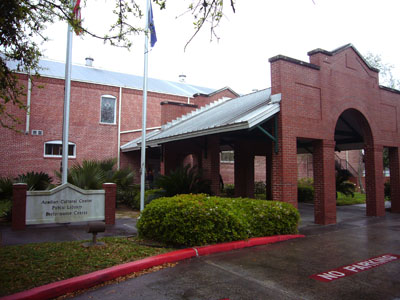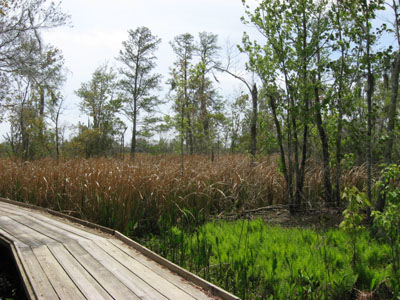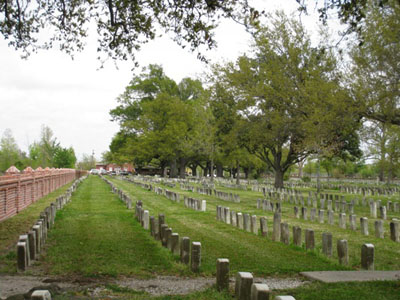
Lafitte dedicated to the Acadian culture
NEW ORLEANS— Jean Lafitte is an interesting name for a national park when you consider what kind of man he really was.
Long debated among historians, Lafitte could be considered either a pirate or a privateer, depended on how you choose to view him.
Born in what is now Haiti in the late 18th century, Lafitte’s deeds became rather dubious in the early 1800s. He started mostly in the Gulf of Mexico, but in 1805, he had opened a warehouse in New Orleans to help disperse goods smuggled in by his brother, Pierre Lafitte. These goods would include slaves, kidnapped by Lafitte from the Caribbean and sometimes from other locations in the U.S.
| At right, the Jean Lafitte Visitors Center is located in the heart of the French Quarter (Photo by Carly Mills). Below, the Wetlands Acadian Cultural Centre is in Thibodaux (Photo by Bruce Garrison). |
The Jean Lafitte National Historical Park and Preserve was officially authorized on Nov. 10, 1978. It is made up of six different and distinct sites across Louisiana, each adding its own piece of history and culture. Three of the locations are dedicated to the Acadian history and culture of the region.
The Acadian Cultural Center is based in Lafayette, about 135 miles west of New Orleans, and tells of the origins and settlement of the Acadians, who later became the Cajuns. The Acadians came from French Canada and were sent to New Orleans when they refused to accept British reign in Canada.
The Prairie Acadian Cultural Center can be found in Eunice, about 171 miles from the French Quarter just west of Lafayette, and focuses on Louisiana’s Prairie Cajuns. It refers to the flat grassy land the Acadians made their home in, before allowing the mix of cultures to make them the Cajuns.
 The Wetlands Acadian Cultural Centre in Thibodaux, about 65 miles southwest of the downtown, looks more at the Cajuns that settled in the Louisiana Bayous. These people relied more on the water and rivers that surrounded them than the Prairie Cajuns.
The Wetlands Acadian Cultural Centre in Thibodaux, about 65 miles southwest of the downtown, looks more at the Cajuns that settled in the Louisiana Bayous. These people relied more on the water and rivers that surrounded them than the Prairie Cajuns.
The second three areas of the park focus more on the other history of New Orleans, how it came together as a city and the troubles it has faced.
The Barataria Preserve in Marrero is Louisiana’s wildest wetlands. Located about a half-hour drive just across the Mississippi River from downtown, it holds 20,000 acres of swamps, marshes and forests.
These water ways are an important part of the park because it is where Jean Lafitte’s men used to smuggle goods into the country.
Chalmette Battlefield at Chalmette, a 15-minute drive from the French Quarter, is a notorious historical site—it is where the Battle of New Orleans took place in 1815 between the United States and the British.
And finally, the French Quarter Visitor Center right in the heart of New Orleans. After the French founded New Orleans in 1718, engineers drew up a formal layout for the city, the area that we now know as the French Quarter. The streets are loaded with history and it is from here that New Orleans grew to become the city we know.
In 1807, the United States laid an embargo upon foreign commerce coming from South America and a lot of products became unavailable to citizens living in the U.S. For Lafitte, it only expanded his market, his workforce grew, slaves and immigrants all lived and worked in the Barataria Wetlands.
This maze of canals, swamp and forest made the perfect place to smuggle in goods as it was right at the mouth of the Mississippi River and provided a boundless amount of hiding places when the authorities came looking.
The six parts of the park are quite diverse and it’s interesting to see how they all came together. In the 1970s, a rich gentleman who wanted to name it after Jean Lafitte bought Barataria. At the same time, the government had been looking at preserving the other five areas for their history and culture. They decided to combine forces and named the whole park after Jean Lafitte in 1978.
| At right, the Barataria National Reserve holds over 20,000 acres of swamps, forests, and marshes. Below, the Chalmette National Park is located outside of New Orleans and commemorates the Battle of New Orleans against the British. |  |
The parks may be different, but staff and volunteer rangers at the various sites are united on their mission statement.
“Our mission is to protect and preserve the history, culture and natural resources and animals therein for the enjoyment of this and future generations and for national heritage,” the park’s managers proclaim on the park Web site.
Specifically for Jean Lafitte, it is to preserve the history and culture of the Mississippi River Delta, including the Cajun and New Orleans areas,” said Park Ranger Cidney Webster, at the Jean Lafitte Visitor Center in the French Quarter.
 And what of notorious Lafitte?
And what of notorious Lafitte?
In 1813, the governor of Louisiana at the time put a price of $500 for his head and Lafitte responded by putting an offer of $15,000 for the head of the governor.
In 1814, he made a deal with governor he and his men would aid Louisiana in the Battle of New Orleans in exchange for them to continue their dealings uninterrupted. Lafitte became a hero and was even pardoned by the president of the United States.
The rangers at the French Quarter Visitor Center have different opinions.
Patricia Corral, the newest recruit to the national park, said was both a good guy and a bad guy,
“He provided goods for the city and he was important to the city, but he also provided slaves, but then, so did Bienville, who founded the city. Lots of men in New Orleans at the time were like Jean Lafitte, just his activities were more recognized. He was more rogue,” she explained.
If You Go
Jean Lafitte National Historical Park Visitors Center
419 Decatur St., New Orleans. (504-589-2636, ext. 1.
Open daily 9 a.m. to 5 p.m. (except Dec. 25 and Mardi Gras).
Get there early for a free tour of the history of the French Quarter. Departs at 9.30 a.m.
Chalmette Battlefield and National Cemetery
8606 W. Bernard Hwy., Chalmette, 504-589-2636, ext 1.
Open daily 9 a.m. to 4.30 p.m.
This site also has the historic Malus-Beauregard House, and the Chalmette Cemetery is next to the battlefield- the final resting place of troops from the 1812 War right up to the Vietnam War.
Barataria Preserve
6588 Barataria Blvd., Marrero (near Crown Point) 504-369-3690, ext 10.
Open daily 9 a.m. to 5 p.m.
Go for a free ranger guided tour of the preserve. Everyday at 10 a.m. and 2 p.m. (only 10 a.m. from June to August). Or, make a reservation for a free guided canoe trek. Available in spring and fall.
Wetlands Acadian Cultural Center
314 St. Mary St., Thibodaux, 985 488 1375.
Open Mondays and Tuesdays, 9 a.m. to 7 p.m.; Wednesdays and Thursdays, 9 a.m.-6 p.m.; Fridays and Saturdays, 9 a.m. to 5 p.m.
Free Delta music jam, every Monday at 5.30 p.m. Bring an instrument and join in! A ranger leads a free walking tour everyday at 2 p.m.
Acadian Cultural Center
501 Fisher Road, Lafayette, 337-232-0789.
Open daily 8 a.m. to 5 p.m.
Free talks on local history and culture available everyday at 2.45 p.m.
In spring and fall, ranger-guided boat tours on the good ship Cocodrie cruise Bayou Vermilion, first settled by American Indians and later home to farmers, trappers, and traders. In spring 2010, boat tours run March 6 through May 29.
Prairie Acadian Cultural Center
250 W. Park Ave., Eunice, 337-457-8499.
Open Tuesdays to Fridays, 8 a.m. to 5 p.m.; Saturdays 8 a.m. to 6 p.m.
Free Cajun music and dancing every Saturday at 3 p.m.
Free cooking demonstrations every Saturday at 4 p.m. Learn how to cook gumbo, étouffée, and other famous New Orleans dishes.

Comments are Closed